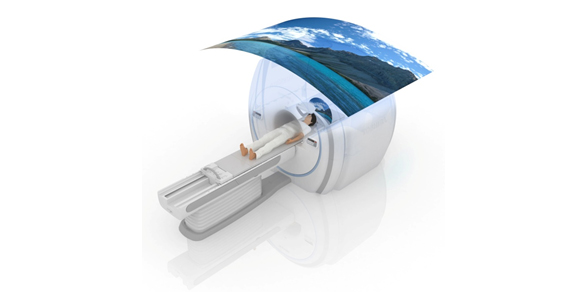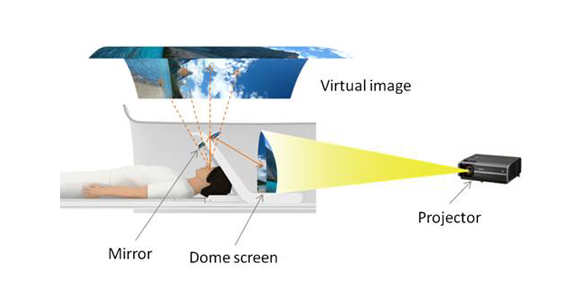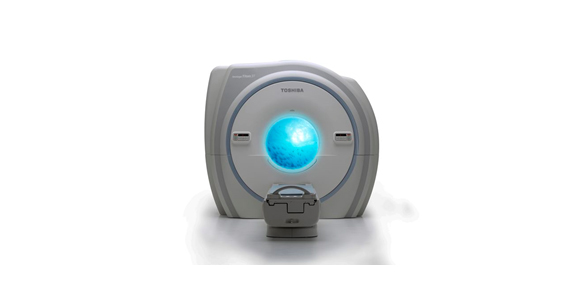New technology to project expansive virtual reality images inside the magnet bore
-Reducing patient anxiety caused by the confined MRI examination space-
Outline
Toshiba Corporation and Toshiba Medical Systems Corporation have developed a technology for displaying expansive virtual reality images inside the bore(Note 1) of MRI systems. High reality images are projected onto a dome-shaped screen (dome screen) in the bore to take the patient's attention away from the actual examination space. This new technology is a reference exhibit(Note 2) at the 101st Scientific Assembly and Annual Meeting of the Radiological Society of North America (RSNA 2015, November 29 to December 4, Chicago).
Development Background
To reduce the patient anxiety caused by the confined examination space and noise during MRI examinations, Toshiba Corporation and Toshiba Medical Systems Corporation have previously developed a 71-cm large-aperture open-bore MRI system and the Pianissimo™ quiet scan technology and released them in the market. The newly developed projection technology further improves patient comfort and reduces the patient stress caused by the MRI examination environment.
Features of the Technique
A semi-transparent dome screen that is moved in synchronization with the patient table(Note 3) is installed inside the bore, and images are projected onto the dome screen and bore cover from a projector, which is installed behind the MRI system, and whose location is unaffected by the magnetic field. The images are reflected by a mirror installed on the patient table and can then be viewed by the patient, providing a visual space that helps take the patient's attention away from the actual examination space.

The core technologies used in the in-vehicle head-up display(Note 4) and ultra-high-presence head-mounted display(Note 5) systems developed by Toshiba Corporation are incorporated in the dome screen installed in the bore. In addition to the center field,(Note 6) where the colors and shapes of objects are processed, image stimulus is applied to the peripheral field,(Note 7) where spatial depth and width and object movements are processed, achieving high reality images with a view angle of as wide as 60° or more. The images reflected by the mirror appear as if displayed on a screen much further away than the actual bore cover, providing an expansive virtual space for the patient in the bore.

Before starting the examination, the dome screen (on which images are displayed) is located at the entrance of the bore. Since the tunnel cannot be seen, patient anxiety related to the examination space is reduced.

When the examination is started, the dome screen is moved into the bore in synchronization with patient table movement, allowing the patient to view images continuously without changing the image size even though during the table movement, suppressing anxiety related to the confined space inside the bore. The high-presence images reflected by the mirror and projected onto the bore cover then come into view, providing the patient with an expansive and bright virtual space.
Future Prospects
Together with our noise reduction technology, this new technology will help achieve a comfortable patient environment that eases patient anxiety in the bore. We will strive for the early commercial release of this feature.
- (Note 1)
- The tunnel in the gantry of the MRI system
- (Note 2)
- This technology is under development and not commercially available.
Due to regulatory reasons, its future availability cannot be guaranteed. - (Note 3)
- The table on which the patient lies during the MRI examination. It is moved into and out of the bore as required according to the progress of the examination.
- (Note 4)
- Toshiba Review Vol. 66 No. 6 (2011).
System for providing drivers with various types of information, such as driving speed and navigation data, by displaying distant transparent virtual images on the windscreen, allowing drivers to check the information while keeping their eyes on the road. - (Note 5)
- SID2006, "Hyper Reality Head Dome Projector (HDP) Using LED Light Source", pp. 2003-2006.
- (Note 6)
- Central 30° of the visual field
- (Note 7)
- Approx. 130° in the vertical direction and approx. 200° in the horizontal direction of the visual field (excluding the center field)
Toshiba Medical Systems Corporation website: http://www.toshiba-medical.co.jp/ (CANON MEDICAL SYSTEMS CORPORATION)


